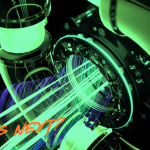Semiconductor and Advanced Manufacturing Powered by Optics Valley
A small part of a $1T global market (by 2030)
In the modern industrial age, light is more than illumination; it’s information, energy, and control. Across semiconductor fabrication and advanced manufacturing, optics and photonics technologies form the unseen infrastructure powering precision, miniaturization, automation, and quality. These technologies rely on a complex ecosystem of light sources, optical components, and imaging and sensor chips, working in unison to fabricate and inspect the world’s most advanced products.
This article explores the foundational role of optics and photonics in enabling the next generation of semiconductors, smart manufacturing, and light-powered computing. These are but a fraction of the technologies and implementations. A complete study of the space would yield a more holistic view of current reality and future potential. Bottom line, the opportunity is enormous.
This is how I see it… Optics Valley is the vortex of today’s tech and tomorrow’s breakthroughs. Harness it. Own it. Drive growth.
About the Author
Let’s be real, I’m not an expert in this industry. But I’ve been in the trenches as an engineer, designer, and systems hacker. I’ve built tech, integrated chaos, and mentored over 3,000 startups (from underwater basketweaving, industrial automation, hydrogen fuel cells, to biotech and medical devices) across 10+ scrappy emerging ecosystems. I’ve seen mindset traps, resource gaps, tribal gatekeeping from those afraid to lose control, and thankfully, breakthrough innovation.
I’ve also spent two decades inside the abundance of mindset-driven Silicon Valley. That experience rewired how I see potential.
What am I an expert in? Curiosity. Patterns. Ecosystems. Opportunity.
I believe our region is sitting on untapped potential. We need bold moves, not business-as-usual. An innovation hub here could change the game, slowing brain drain, fueling talent, and creating the kind of economy that works for more of us.
This series isn’t about theory. It’s about lighting a fire. Let’s collaborate bigger, move faster, and make some noise.
Light-Based Technologies in the Manufacturing Landscape
At its core, photonics is light generation, manipulation, and detection. In semiconductor and advanced manufacturing, this involves:
- Projecting patterned light to etch nanometer-scale circuits.
- Using lasers to heat, cut, weld, or build components.
- Measuring dimensions, defects, and material composition with optical sensors.
- Moving and analyzing massive amounts of data via light-based interconnects and vision systems.
From laser-based lithography to fiber-optic sensing, the manufacturing ecosystem is undergoing a quiet revolution fueled by photons.
Light Sources: The Engine of Photonic Systems
Various light sources power the full spectrum of manufacturing functions:
Excimer and EUV Lasers (Semiconductor Lithography)
- Deep Ultraviolet (DUV) lasers (e.g., 193 nm ArF) are used in traditional photolithography.
- Extreme Ultraviolet (EUV) light at 13.5 nm enables advanced nodes (<7 nm), requiring precision optical mirrors and vacuum environments.
- EUV light is created using high-energy laser-produced plasma (LPP), one of the most complex photonic systems in commercial use.
Femtosecond and Picosecond Lasers (Material Processing)
- Ultrafast lasers deliver high-precision ablation with minimal heat-affected zones, perfect for thin-film patterning, MEMS fabrication, and OLED display production.
Fiber and Diode Lasers (Machining & 3D Printing)
- Used in additive manufacturing, cutting, welding, and engraving, with high energy efficiency and beam quality.
LEDs and UV Sources (Inspection and Curing)
- Broadband LEDs power machine vision, while UV-C LEDs are used for photopolymerization and surface disinfection.
- Pulsed light sources are used for photonic sintering, especially in printable electronics.
Optical Components: Shaping, Guiding, and Filtering Light
Light’s behavior must be finely controlled through complex optical systems:
Lenses and Objectives
- Used for beam focusing, imaging, and wafer inspection, often designed for UV, IR, or visible ranges.
Mirrors and Reflective Optics
- Multilayer mirrors for EUV lithography must maintain atomic-scale smoothness.
- Galvanometer-controlled mirrors steer lasers in additive and subtractive manufacturing.
Fiber Optics and Waveguides
- Used to transmit light for sensing and communication across manufacturing equipment and factory networks.
- Photonic integrated waveguides are paving the way for ultra-fast, light-based signal processing.
Filters, Polarizers, and Beam Shapers
- Isolate specific wavelengths, enhance contrast, and modify beam profiles.
- Diffractive Optical Elements (DOEs) are used in advanced beam shaping for materials processing.
Spatial Light Modulators (SLMs)
- Dynamically control light patterns key in maskless lithography, laser projection, and 3D optical imaging.
Imaging and Sensors: CCD, CMOS, and Photonic Chips
CCD and CMOS Image Sensors
- Charge-Coupled Devices (CCD) and Complementary Metal-Oxide-Semiconductor (CMOS) sensors convert light into electronic signals and are essential in: Wafer inspection Machine vision, Metrology, and quality control
- CMOS sensors have become dominant due to their lower power usage, smaller size, and easier integration into smart devices and factory automation systems.
Time-of-Flight (ToF) and LiDAR Sensors
- Use modulated light to measure distances and map surfaces in real time.
- Critical for robotics, AGVs, and precision alignment systems.
Photonic Integrated Circuits (PICs)
- Integrate light sources, waveguides, and detectors on a single chip.
- Enable faster, lower-energy interconnects than traditional electronics keys for smart factories for AI, datacenters, and high-speed control.
Emerging Light-Based Chips
- Neuromorphic photonic chips mimic brain-like computing using photons, offering high-speed, low-power alternatives for edge computing.
- Quantum photonics chips use entangled photons to enable ultra-secure communication and quantum computation.
Optics doesn’t just support these chip innovations; they are becoming optical systems themselves.
Optics and Photonics in Semiconductor Fabrication
Lithography
- Light is projected through a photomask and focused via precision optics to create circuit patterns on wafers.
- EUV systems require vacuum chambers, nanometer-scale positioning, and adaptive optics.
Laser Annealing and Doping
- Controlled heating via lasers improves electrical performance and device reliability.
- Enables shallow junction formation with precision unachievable by furnace-based systems.
Optical Metrology
- Techniques like interferometry, ellipsometry, scatterometry, and Raman spectroscopy analyze layer thickness, material composition, and pattern fidelity.
- Enables real-time, non-contact process control.
Automated Inspection
- Image sensors and optical microscopes detect defects like scratches, voids, and pattern shifts at the nanometer scale.
Photonics in Advanced Manufacturing Applications
Additive Manufacturing (3D Printing)
- Lasers selectively fuse or sinter materials layer by layer.
- Beam shaping optics and scanners enable high-speed, high-precision builds.
Subtractive Manufacturing
- Laser cutting and drilling tools use focused beam optics to achieve high throughput with minimal mechanical wear.
Laser Surface Engineering
- Laser texturing, cladding, and cleaning enhance adhesion, reduce friction, or prepare surfaces for coating.
Machine Vision and Robotics
- CCD/CMOS sensors combined with structured light, hyperspectral, and thermal imaging identify flaws, enable automated sorting, and power robotic guidance.
Light-Driven Sustainability
Photonics offers a cleaner, more energy-efficient manufacturing pathway:
- Laser processing reduces material waste and eliminates cutting fluids.
- UV sterilization eliminates chemical disinfectants in cleanrooms.
- Optical sensors provide real-time environmental and energy monitoring.
These technologies support green manufacturing without compromising precision or speed.
Smart Factories, Industry 4.0, and Beyond
As factories become more intelligent and more connected, optics and photonics are the digital nervous system:
- Fiber optic sensors monitor structural integrity, heat, and strain across machines and buildings.
- Optical data links move vast quantities of data quickly between machines, robots, and control systems.
- LiDAR and 3D vision systems support autonomous movement, predictive maintenance, and adaptive production lines.
The Future: Light as a Computing Medium
The line between light as a tool and light as a processor is blurring:
- Integrated photonics will enable light-based logic and data movement within chips.
- Optical AI accelerators could transform machine learning performance per watt.
- Quantum photonic chips will revolutionize simulation, optimization, and secure communications.
These breakthroughs demand new design paradigms, cleanroom capabilities, and a skilled workforce trained at the intersection of photonics and electronics.
Conclusion: Light is the Future of Manufacturing
From EUV lithography and laser machining to CMOS imaging and neuromorphic photonic chips, optics and photonics are the invisible backbone of modern manufacturing. They power how things are made and how machines think, see, and learn.
Investments in optics and light-based technologies haven’t been optional; they are essential for any region, company, country, or globe competing in the digital economy. Mastering light means mastering the future.
The optics-photonics-enabled industries will surpass $1 trillion globally by 2030, driven by transformative applications in AI, health tech, quantum computing, and clean energy. We should elevate our planning and execution to include this catalyst for innovation and growth.








